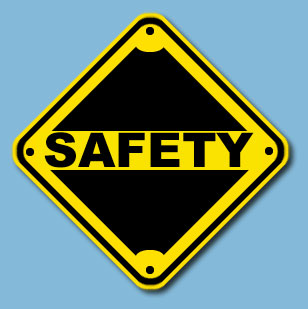 Following these principles of leadership will help you and your employees focus on job safety:
Following these principles of leadership will help you and your employees focus on job safety:
- Don’t walk by. It is everyone’s responsibility to prevent any potentially unsafe acts and conditions they witness from turning into accidents.
- STOP! Encourage employees to stop working whenever they feel unsafe, no matter what reason they give.
- Focus on a safe working environment. If you expect your workers to work safely, make their workplace as safe as possible.
- Don’t blame the worker first. Unsafe ways of working, accidents, incidents, and ill health aren’t necessarily the worker’s fault. The problem often comes from less obvious causes, such as decisions by management.
- Use your workforce for ideas. Employees often have a more accurate idea than you or your managers about which safety and health practices will work, because they deal with these issues every day.
- Be patient. Don’t expect quick wins. Improvements will emerge over time, but only if you stick with them.
- Explain your decisions. Just telling workers that something is wrong or a safety risk isn’t enough. If they’re to act on the information you provide, they need to know why and how to avoid harm.
- Lead by example. Your behavior sends powerful signals. If you carry out your job in a safe way, your workers are more likely to do the same. If you don’t, they won’t imitate you.
- Focus on co-operation. Treat your subcontractors in the same way as employees by encouraging them to communicate with each other.
- Don’t neglect occupational health. If you look after the health, as well as the safety, of your workers today, you’re less likely to create problems for them or your business tomorrow.
Sound advice!
Read more
Safety is more than a set of activities focused on accident prevention. It is a way of thinking about how you work, and it should be at the heart of any successful company. Weaving safety into your company’s mission, policies and procedures is a great way to demonstrate its importance and ensure its effectiveness across your company.
It should be about a shared vision that is expressed by core values and behaviors, where everyone walks the talk. By addressing unsafe acts and conditions before they become accidents, you build your safety culture.
Four Steps to a Safety Culture
The following four steps can serve as a starting point in driving safety across your business.
1. Evaluate risks. To understand how to create a safer workplace, you must first understand the risks you face every day. Each task and associated risk should be properly evaluated, and safety-based changes should be considered.

– Analyze past incidents and near misses. Understand that past incidents can help you identify root causes and identify risks and exposures that threaten the safety of your employees and the success of your business.
– Identify the risks before they result in loss. Review your work policies and procedures, buildings and equipment, employee work practices and behaviors and geographic location to determine if there are opportunities to prevent or mitigate loss. And hold people accountable to the practices.
2. Design a plan to keep safe. A good plan is the best place to start, but it is only the beginning. Once you have a plan, you must act to eliminate or minimize risk.

– Get commitment. Your management team should be committed to a safety culture from the beginning.
– Stay focused. Keep focused on the risks and exposures identified during your evaluation.
– Prioritize your efforts. Focus on the risks that pose the greatest threat. You should consider frequency and severity of the loss potential, and/or the opportunity to prevent or mitigate risks.
– Identify solutions and resources. Your solutions can vary from implementing engineering controls to creating administrative policies and procedures. These can help create positive changes in safety attitude, commitment and culture.
3. Implement your plan. Implementation entails communication of the plan and its details, training, regularly scheduled practice and drills, and ongoing review. A thorough plan will cover a number of potential risk areas, including buildings and equipment, the environment, employees, customers and vendors.

– Communicate and train – the real test of a safety program and culture is not what is written down on paper, but rather how well it actually works. How well your plan works is often dependent on what your employees know and what they do at the time of an incident.
4. Monitor, evaluate and improve your plan. As your business environment changes, so should your safety program. Regularly test your plan to determine if it fits the changing business environment and reflects changing accountabilities.

– Monitor the plan and collect feedbackto determine the effectiveness of the plan.
– Regularly compare your safety performance against the plan’s expectations.
– Make adjustments when necessary.
– Recognize success. Be sure to communicate and celebrate your safety successes.
At Scurich Insurance Services, our team of risk specialists visit more than one hundred properties every day, and are able to share lessons learned and insights for helping create a safety culture. Start building your safety culture today. Learn more about developing your safety management program.
Read more
 Everybody has felt that unpleasant surprise when a car comes zooming into view after being hidden in a blind spot. Older motorists are no different, and they see warning systems against this hazard as the top safety feature in newer cars, according to a new report by the MIT AgeLab and The Hartford Insurance Company. After surveying hundreds of drivers over age 50 who get behind the wheel at least three times a week, the study found that these “mature motorists” felt more confident with cars which have at least one of 10 advanced safety technologies.
Everybody has felt that unpleasant surprise when a car comes zooming into view after being hidden in a blind spot. Older motorists are no different, and they see warning systems against this hazard as the top safety feature in newer cars, according to a new report by the MIT AgeLab and The Hartford Insurance Company. After surveying hundreds of drivers over age 50 who get behind the wheel at least three times a week, the study found that these “mature motorists” felt more confident with cars which have at least one of 10 advanced safety technologies.
Here are the top 10 safety features for older motorists (in order):
- Blind-spot warnings alert drivers when another vehicle is approaching unseen and also help with parking.
- Crash mitigation systems detect imminent collisions and can help reduce passenger injuries.
- Emergency response systems alert paramedics or other emergency personnel if there’s an accident.
- Drowsy driver alerts warn motorists when they nod off or otherwise become inattentive.
- Reverse monitoring systems help drivers (especially those with reduced flexibility) judge distances and back up safely by warning of objects behind the vehicle.
- Vehicle stability control reduces crashes by helping steer a car if it veers offline or has trouble navigating a curve.
- Lane departure warning alerts motorists when they drift from a lane.
- “Smart” headlights illuminate the road more effectively by responding to the direction the driver is steering and the vehicle’s speed.
- Voice-activated command systems allow motorists to use a car’s features without losing focus on the highway.
- Automated parking assist calculates the angles and steers the car into the space, reducing driver stress and increasing the number of potential parking spots.
How many of these safety features does your newer car have?
Content provided by Transformer Marketing.
Read more
 Following these principles of leadership will help you and your employees focus on job safety:
Following these principles of leadership will help you and your employees focus on job safety:




